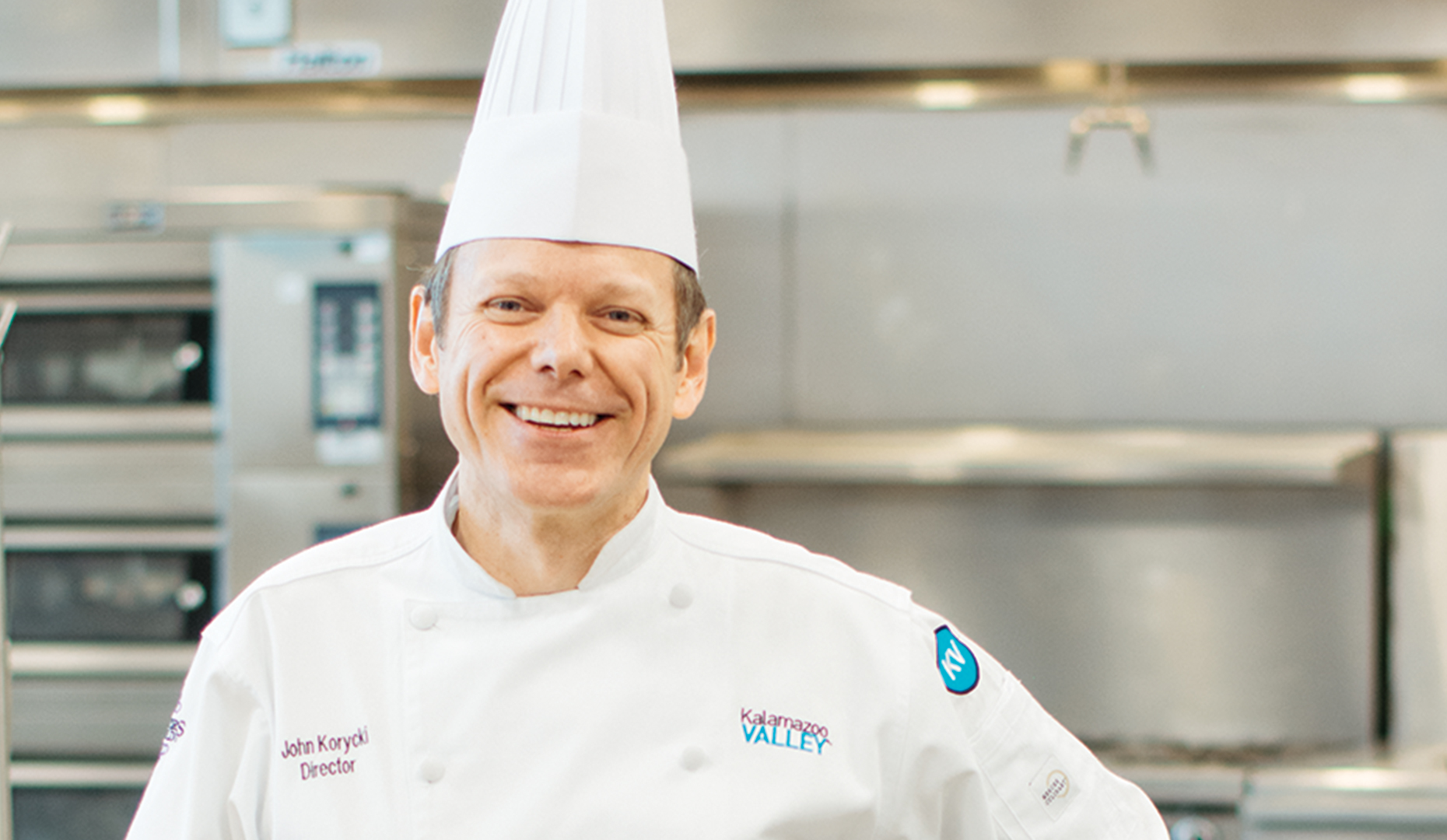John Korycki may be Director for Culinary Education at Kalamazoo Valley, but his love for food and cooking goes all over the place.
John Korycki
- Director for Culinary Education, Kalamazoo Valley Community College, June 2015—present
- Executive Chef, Greenleaf Hospitality Group, August 2004—April 2015
Founding Chef, Zazios - Kendall College, Associate of Arts and Sciences, Culinary Arts, 1989—1991
What does your role as Director for Culinary Education entail at Kalamazoo Valley Community College?
I’m responsible for developing the curriculum for a big idea, like a culinary school in Kalamazoo, become reality. There has been a lot of amazing groundwork and foundation building not only for the building, but for the coursework over the past six years. Besides designing the curriculum, I get to teach a few classes, like Food Industry Career Planning.
For me, it’s kind of like turning back the clock 11 years ago when I was given the opportunity by Greenleaf Hospitality to be a part of something new, Zazios Restaurant. In both cases, they gave me the “hardware” and assigned me to build the “software.” Right now at Kalamazoo Valley Community college, the “hardware” is working, the “software” is developed and now I have to make sure it does what it is supposed to together.
Why did you make the move to serve as Director for Culinary Education?
I mentioned to the team at Kalamazoo Valley Community College that I’d welcome the opportunity to be part of the program. I sent in my application to be one of the chefs that would be part of the program. They then gave me a bigger application to be the director of the program.
What are your goals for the program?
To fill up every seat in all the courses! Graduates will earn an Associate of Applied Science in our Culinary Arts program. In our Sustainable Brewing program, those demonstrating proficiency can earn a Certificate in Sustainable Brewing, an Associate of Applied Science degree in Sustainable Brewing and/or an Associate Degree for Transfer to West Michigan University to earn a Bachelor of Science degree in Sustainable Craft Brewing. We had a fabulous start with our two fall 2015 terms. You can say that our program will grow the food, cook the food and brew the food!
Culinary students and brewing students will be introduced to sustainable food systems in our program. We are emphasizing the health, wellness and nutritional aspects of the culinary arts. Students will get their hands in the dirt or non-dirt growing systems and see what it takes to grow food too. This program mirrors what I went through at Kendall College in Chicago or what you would go through at the Culinary Institute of America in New York or Johnson & Wales College of Culinary Arts in Providence, Rhode Island. All are based on “Old World” European history and techniques.
When it comes to nutrition, we are working as a team on what changes need to be made for both our nation and our community: the challenges of heart disease, obesity and children’s nutrition. We want to focus on fruits and vegetables rather than on the meat-centered plate. It’s now about how beans, greens, legumes and grains play a part. We’re paying attention to what Michael Pollan, a contributing writer for the New York Times Magazine, writes about concerning the current industrial food chain. We’re also paying attention to something Chef Alice Waters started in the 1970s in California: use local, be sustainable and organic as possible, and look at health and nutritional quality of food. As a number of our buildings are located adjacent to the Edison Neighborhood in Kalamazoo, we are about communicating the types of healthy foods that differing income levels can purchase at their local supermarkets. Everyone should look at the labels whether you are shopping at Family Dollar or Meijer.
When I contacted you, you were in Italy. Do you still do group tours?
For ten years, I’ve been taking an annual trip to Italy, along with 7 to 19 fellow food adventurers. I pick a relatively small area to travel to enjoy 10 days, 10 nights and 10 meals. Those who are interested in joining me on my next trip can find me on Facebook at CHEF-JK-Travels.
Where are your favorite places to travel to?
Italy (no specific area). Chicago. Nashville. The Kalamazoo Farmers’ Market on Saturday morning.
What restaurants do you recommend in Southwest Michigan?
Since my work closely ties me to downtown Kalamazoo these days, my wife Stacey, and I frequent my alma mater of course – Zazios, as well as Old Dog Tavern, Rustica and Principle Food & Drink. Closer to home, we visit Chin Chin in Mattawan.
When did you know that you wanted to become a chef?
It was at the point that I knew I wasn’t going to make it as a serious amateur biker, like in the movie Breaking Away. During my time as a student at Illinois Institute of Technology in Chicago studying electrical engineering, I took some time off—like five years—to pursue my biking dream. My mom and dad “loved” me for that decision and I grew up in an amazing Polish household on the southwest side of Chicago. My mom was an amazing cook and my dad worked at Vienna Beef. I got the best Chicago dogs and Vienna corned beef before it made if off to the supermarket. In our backyard, my mom managed the herb garden while my dad managed the square foot of a lawn. Every year, we had tomatoes, cucumbers, dill, chives and parsley.
During my racing years, I held down a job that basically helped me go to bike races on weekends. For five full years, I was serious athlete and the guy who ate pasta eight days out of the week while riding 250 to 500 miles. I saw how easy and inexpensive cooking pasta was, as well as learned how your body reacts to different foods and nutrients at different athletic events. One of my best friends in cycling lived about five minutes away from me and, after bike races on the weekend, we often ended up back at his house. I heard stories from his dad who was a food broker in the Chicago area about what chefs were doing in the local hotels. Then, the aha-moment came: WGN-TV Channel 9 featured restaurants on the evening news on Thursday or Friday nights. One night, they featured Kendall College’s culinary program. I thought, “That’s the school for me. I’ll get to go to school dressed in white coats and tall chef hats and play with food. I think that’s what I want to do.” I’ve loved being in the kitchen ever since.
How do you become a great chef?
Love what you do. Listen to your people—which means your guests, your family, and your staff. Never stop learning. Get to class on time. Get to work on time. Play well with your teammates and classmates who have chef’s knives in very small confined places. The hard stuff is when it comes to managing and coaching. It doesn’t matter if you’re in business, the private sector or a restaurant. The cooking stuff is the easy part. A good chef uses connections and uses networks. If you do those things, then good things will come to you. For young cooks, I never consider anyone coming out of culinary school a “chef,” until they have earned a lengthy background of leading, managing and coaching, along with a good set of cooking skills.
Who is the main “chef” at your house?
Lately, my wife and I continue to play the game: “Hey, What’s for Dinner?” It’s who asks whom as early in the day as possible. We share the responsibilities. And like everyone else with two kids, we go out, order in, and are sometimes ok with three boxes of cereal and milk on the table. We currently have one in college and one in high school and sometimes it’s four of us and sometimes two. We’re flexible.
Who is your biggest critic?
At home, my wife.
Why do you think people are fascinated by chefs these days?
Chefs can take a raw product, do some magic to it also known as cooking, and make something that tastes good which makes someone feel good. The process is rather quick. You do your best with what Mother Nature has given you and, for the most part, you give it to the recipient and they get to enjoy it. Most chefs see their guests and get instant feedback on their process. There’s a human connection to it.
Who is your favorite celebrity chef and why?
If I ever wanted to hang out with one, it would be Anthony Bourdain. I like the way he travels and tastes food.
What can we find on your TV?
The Walking Dead! It’s probably not the cooking show that you might expect.
Chef John Korycki’s Grocery List: 12 Things to Keep in Your Pantry
- Olive Oil
- Balsamic Vinegar
- Onions
- Garlic
- Boxed Pasta
- Chunk of Parmigiano
- Salt
- Lemon/Lime
- Red Hot Chili Peppers
- Brown Rice
- Dry Beans
- And when all else fails … a jar of Nutella.
From John’s Cookbook: Spring Asparagus Frittata with Morel Mushrooms
Appetizer, serves 6–8
- 3 tablespoons extra virgin olive oil
- ¼ pound fresh morel mushrooms, washed well, trimmed
- ½ pound asparagus, sliced diagonally into 1-½ inch slivers
- 6 large eggs, local/organic
- 6 tablespoons water
- ¼ cup parmigiano-reggiano, grated to taste
- Sea salt or coarse Kosher salt
Pre-heat oven to 400 degrees F
Heat large oven-safe (non-stick) sauté pan over medium heat. Add olive oil and morels and sauté until fully cooked. Add the asparagus and sauté until it becomes tender, 4 to 5 minutes, seasoning lightly with salt.
Remove from heat
Meanwhile, lightly beat the eggs in a bowl with the water, seasoning with salt. Add grated parmigiano, stirring to combine. Add the egg mixture into the sauté pan. Cook the eggs, gently stirring until eggs begin to set around the edges and bottom.
Place pan in oven and bake the frittata until eggs are cooked through and frittata is browned on top, about 4 to 6 minutes.
To serve, slide frittata onto serving plate, and cut into small wedges. Frittata may be served hot, warm, or cool at room temperature. Serve with an additional drizzle of olive oil or a grating of parmigiano cheese.
Enjoy!




